One of the most instantly recognizable creatures of the sea, hammerhead sharks have long been the subject of both controversy and amazement. Most of our knowledge about this complex group of species is relatively new and sheds fascinating light on shark behavior and evolution.
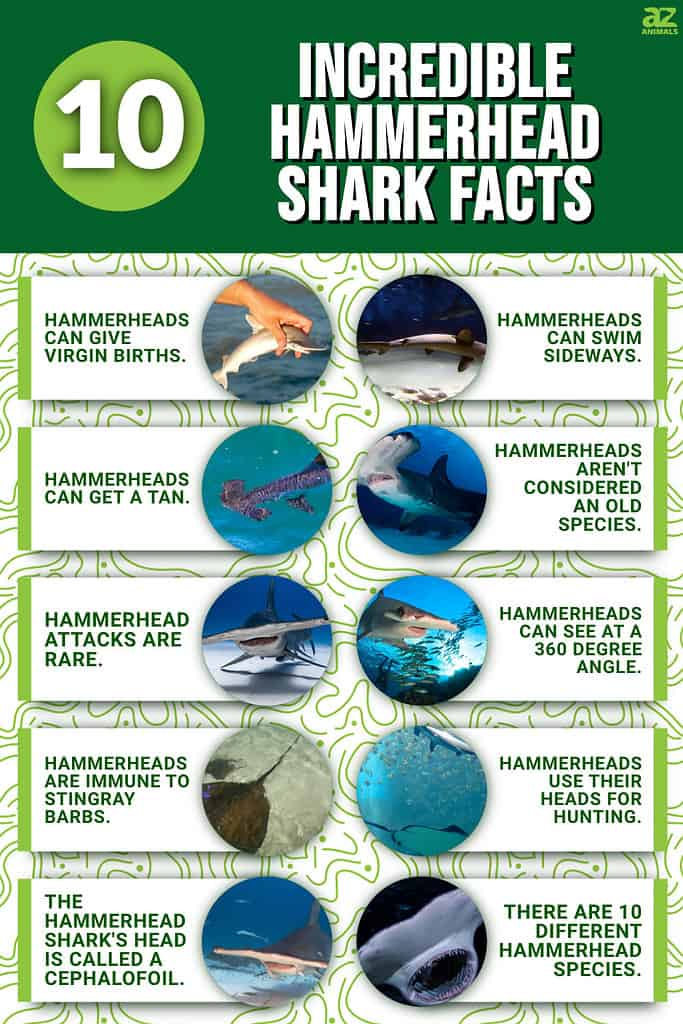
There are also many things we simply don’t know or don’t have the contributing research to confirm, so more study is needed to unlock all of the secrets of the hammerhead. While we wait for new findings to come in, let’s take a look at 10 incredible hammerhead shark facts!
10. There are ten different species of hammerhead sharks
Nine hammerhead species occupy the same genus (Sphyrna), and one has its very own genus (Eusphyra). The genus name “Sphyrna” actually comes from the Greek word “hammer.”
Eusphyra is derived from the Greek words “good” or “true” in conjunction with “hammer.” The ten species of hammerhead are:
- Winghead shark (Eusphyra blochii)
- Scalloped bonnethead (Sphyrna corona)
- Whitefin hammerhead (Sphyrna couardi)
- Carolina hammerhead (Sphyrna gilberti)
- Scalloped hammerhead (Sphyrna leweni)
- Scoophead (Sphyrna media)
- Great hammerhead (Sphyrna mokarran)
- Bonnethead (Sphyrna tiburo)
- Smalleye hammerhead (Sphyrna tudes)
- Smooth hammerhead (Sphyrna zygaena)
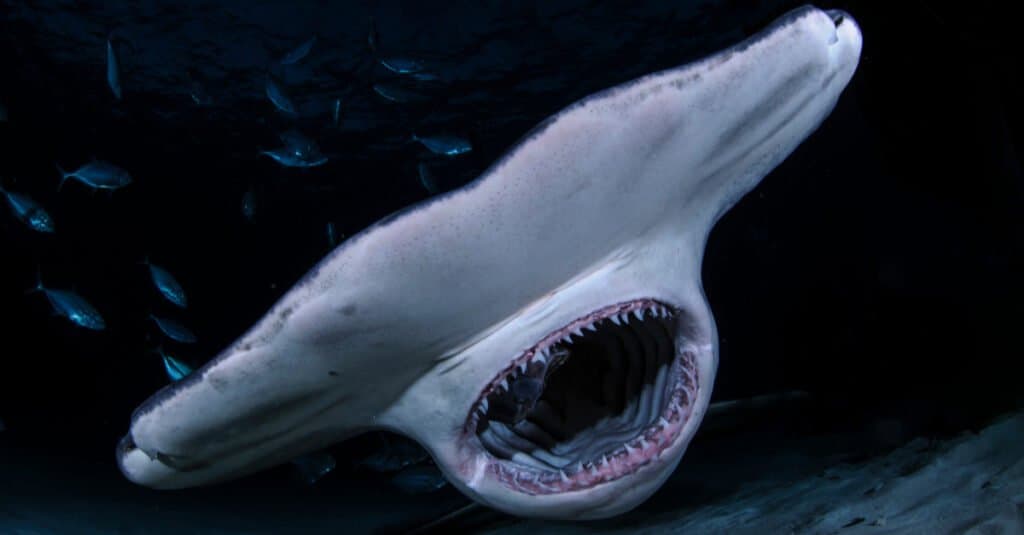
A close up of a
hammerhead shark
!
©Martin Voeller/Shutterstock.com
9. The hammerhead portion of the shark is called a cephalofoil, and it’s a seriously cool shark adaption
The cephalofoil is responsible for the distinctive shape of the hammerhead group and gives them incredibly effective binocular vision and superior depth perception. Scientists also think the size of the cephalofoil gives hammerheads more electroreceptor organs than other sharks, increasing their ability to navigate vast distances and detect the electrical fields surrounding possible prey.
Hammerheads are found worldwide and mostly in warmer waters along coastlines. Unlike most sharks though, some hammerhead species actually swim in schools rather than solo. Some of these hammerhead schools can be located near Malpelo Island in Colombia. Another interesting fact is that hammerhead sharks have very small mouths compared to other shark cousins.
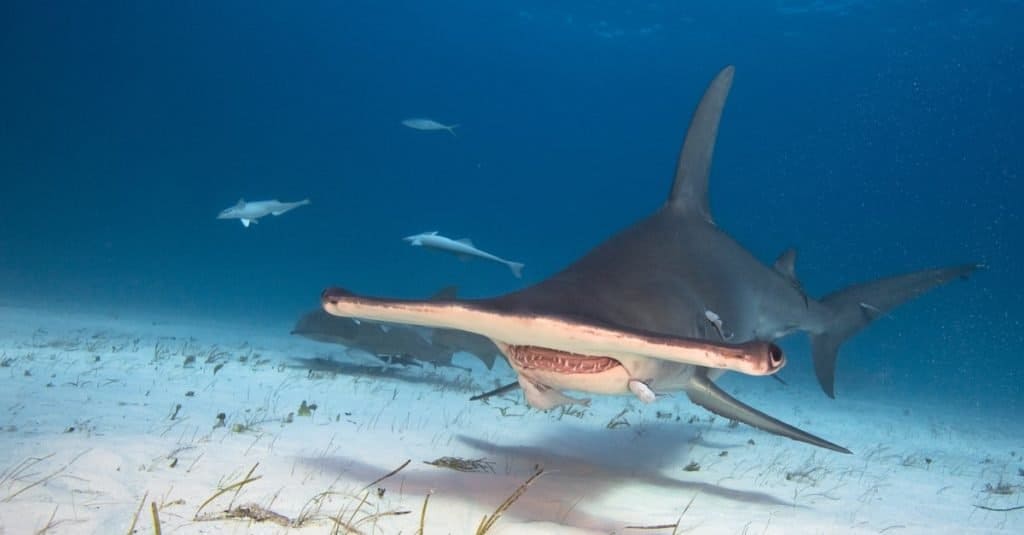
This shark’s name comes from the unusual shape of its head, an amazing piece of anatomy.
©frantisekhojdysz/Shutterstock.com
8. Some hammerheads use their “hammer heads” to aid in hunting
In addition to the incredible visual prowess the cephalofoil gives hammerheads, it’s been observed that they actually use their heads to ram into and pin down stingrays, forcing them into the substrate (ocean floor). This repeated action eventually tires out the stingray, making it easier for the sharks to eat them.

A hammerhead shark will pin down and eat a
manta ray
as well as a stingray and other prey.
©CHEN MIN CHUN/Shutterstock.com
7. Hammerheads appear totally unaffected by venomous stingray barbs
Stingray barbs have been known to cause fever, nausea, swelling, and even seizures in humans. The barbs are also incredibly sharp and have resulted in some deaths, including, famously, Steve Irwin’s (the Crocodile Hunter). Hammerheads don’t seem to mind; in fact, many great hammerheads have been found with pieces of stingray barbs embedded in their faces.
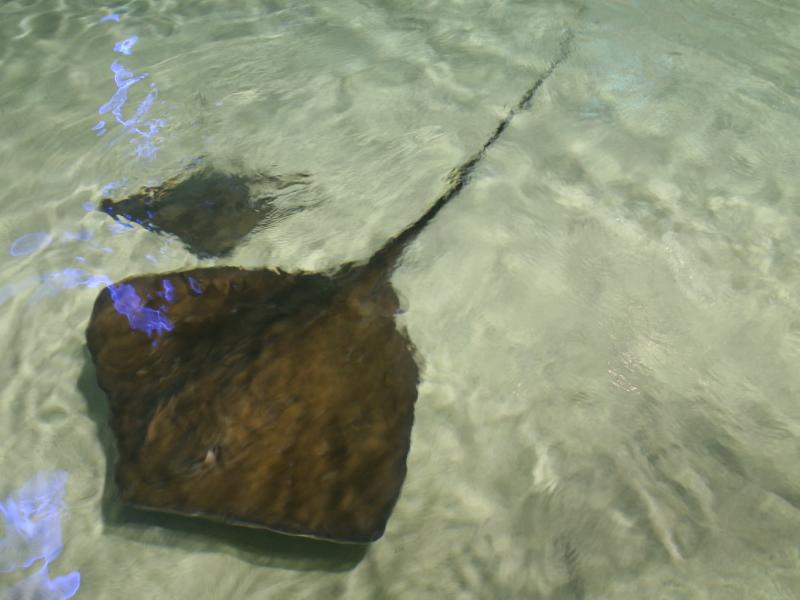
The spinal blade of a stingray can secrete venom; both the blade and venom are dangerous.
©Cliff / Creative Commons – Original
6. The position of a hammerhead’s eyes gives it an outrageous 360 degrees of vision.
Each eye is positioned at each end of the lateral head extension, meaning they can see nearly everything around them all of the time. The one exception is the large blind spot right in front of their noses. Divers have made claims that some small fish will hide in the hammerhead’s blindspot as if to say, “Ha! You can’t see me!”
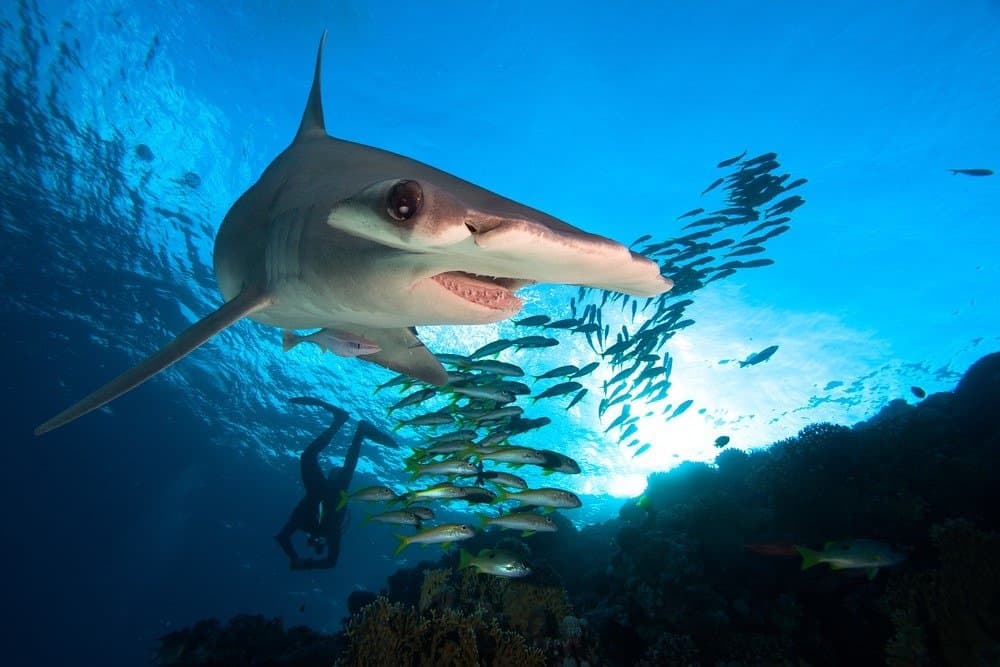
Hammerheads have large eyes positioned to give them an all-around view, except for the tip of the nose.
©frantisekhojdysz/Shutterstock.com
5. Despite their mean appearance, hammerhead attacks are rare.
There have only been 17 recorded attacks globally and zero fatalities. Most attacks occurred when the sharks were provoked or unintentionally caught in fisher nets. Hammerheads also have disproportionately small mouths compared to their other shark brethren.
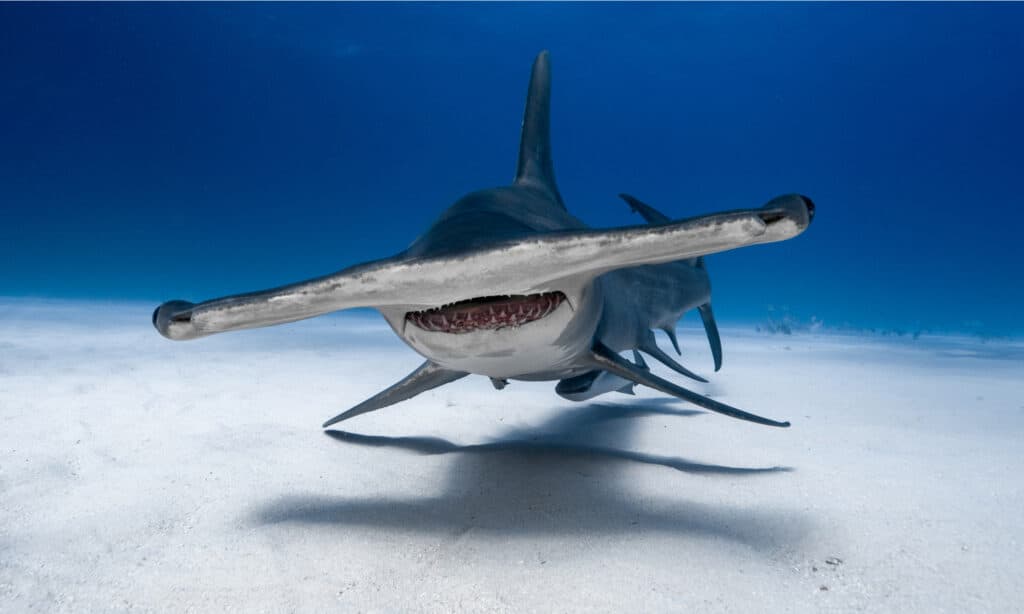
Hammerheads can be aggressive hunters and will attack if threatened, but otherwise humans are safe.
©Sail Far Dive Deep/Shutterstock.com
4. Hammerheads aren’t nearly as old as many other sharks.
Some species of sharks have been called dinosaurs since they existed concurrently with them, but not the hammerhead. In the grand scheme of shark presence on earth, they are relatively new, having most likely emerged during the Miocene Epoch (23-5.3 million years ago). The dinosaurs went extinct roughly 65 million years ago.
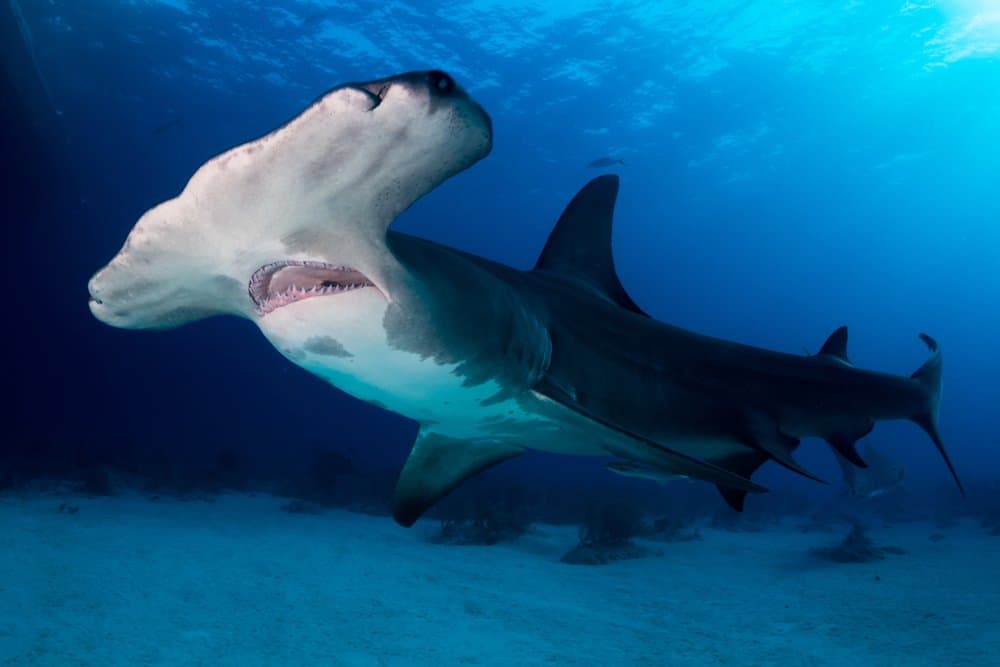
Hammerheads appeared about 23 million years ago, but there have been sharks for 420 million years.
©HakBak/Shutterstock.com
3. Hammerheads can get tans!
Due to their propensity for hanging out in shallow waters, some hammerheads can actually tan, turning from light brown to nearly all black. There are also zero known cases of skin cancer in the sharks. Further study of how they can tan without getting cancer may be critical in uncovering how to prevent and treat melanoma. Tanning without the risk of melanoma? I’d say that’s a pretty incredible adaption.
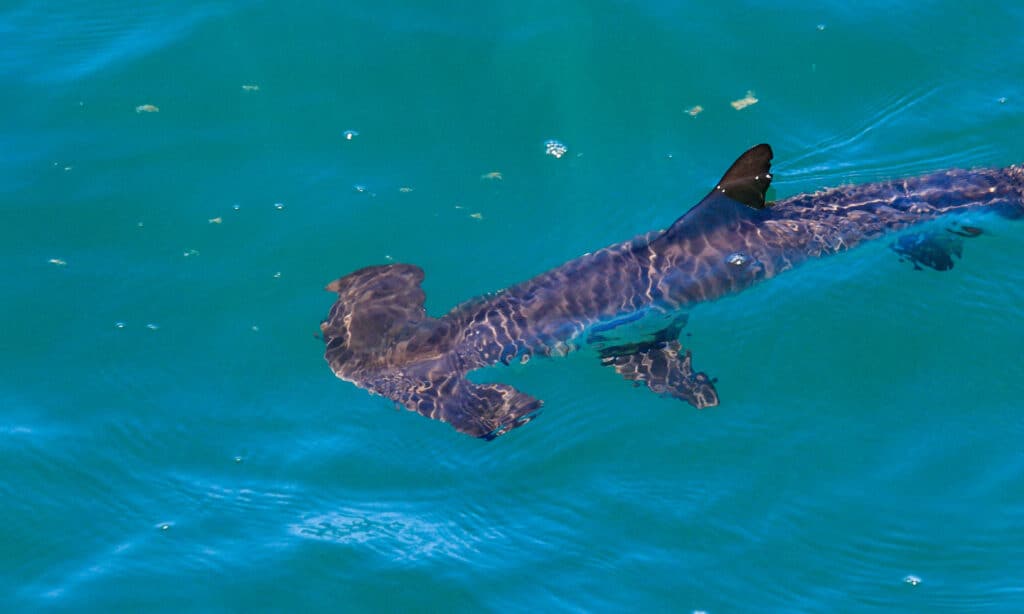
Since hammerhead sharks spend so much time in shallow waters, they can actually get a tan!
©iStock.com/Alessandro De Maddalena
2. Great hammerhead sharks like to swim sideways!
Typical sharks have eight fins, the most recognizable of which is the dorsal fin; they also usually have two pectoral fins. In most sharks, the pectoral fins are longer than the first dorsal fin, but that’s not the case for hammerheads, which affects how they move. In a 2016 experiment published in the Journal of Experimental Biology, GoPros were attached to hammerheads to document how they swim. After reviewing the footage, it was found that the sharks spent almost 90% of the time flipped to their side somewhere between 50-75 degrees. Scientists suspect that when hammerheads do this, their dorsal fin acts more like an additional pectoral fin, reducing drag and expanding their wingspan, which increases swim efficiency.

Great hammerheads spend the majority of their time swimming sideways
©Littlegreenman, Public domain, via Wikimedia Commons – Original / License
1. The first shark case of virgin birth occurred with a hammerhead.
Possibly one of the most bizarre facts about hammerheads involves a bonnethead shark in captivity at an Omaha, Nebraska aquarium. The bonnetheads at the aquarium were all female, and in 2001, one of them had a virgin birth, that is to say, birth without the contribution of a male. Testing confirmed that the new shark did not have any paternal DNA. This was the first case of virgin birth observed in sharks. To quote Ian Malcolm from Jurassic Park, “Life, uh, finds a way.”
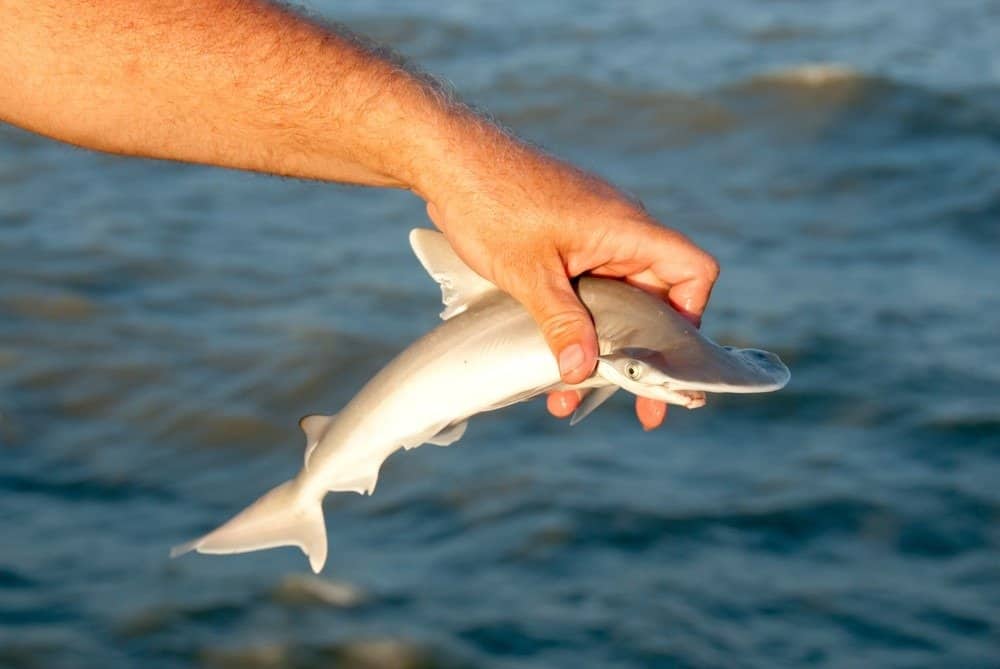
A baby hammerhead shark is quite small compared to its enormous size as an adult.
©starryvoyage/Shutterstock.com
Summary of 10 Incredible Hammerhead Shark Facts
| Rank | Hammerhead Shark Facts |
|---|---|
| 10. | There are 10 different hammerhead species. |
| 9. | The hammerhead shark’s head is called a cephalofoil. |
| 8. | Hammerheads use their heads for hunting. |
| 7. | Hammerheads are immune to stingray barbs. |
| 6. | Hammerheads can see at a 360 degree angle. |
| 5. | Hammerhead attacks are rare. |
| 4. | Hammerheads aren’t considered an old species. |
| 3. | Hammerheads can get a tan. |
| 2. | Hammerheads can swim sideways. |
| 1. | Hammerheads can give virgin births. |
Bonus Fact: Hammerheads are movie stars.
If you love 90’s Disney movies, you may remember seeing hammerhead sharks in the movie adaption of the 1960’s show Flipper. In the movie version (released in 1996), a bottlenose dolphin protects a young Elijah Wood from a hammerhead shark.
Well, there you have it, some interesting, bizarre, and downright fascinating facts about hammerhead sharks! Hopefully, more information comes out in the next few decades about these adaptive and interesting predators.
Thank you for reading! Have some feedback for us? Contact the AZ Animals editorial team.







